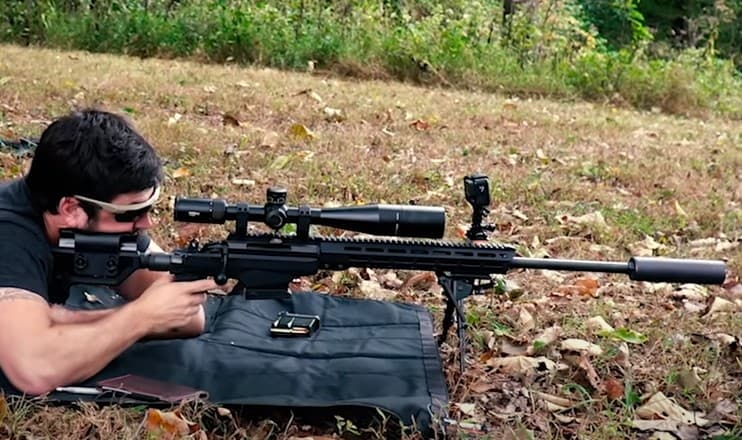How To Choose A Reticle For Long-Range Shooting?

Long-range shooting is difficult, extremely difficult. To effectively engage a long-range target, you have to have two basic things.
First off, you have to have the skill. The skill needed to make long-range shots is not one you can replace with equipment.
Long-range shooters are an extremely disciplined group of shooters, and the skills they have are built over the years.
It would require more than a single article to tell you all the factors you have to consider when learning to shoot at long ranges.
The next thing you need is proper equipment. Proper equipment includes the proper rifle, the right round and load for it, and the rifle scope is one of the most important pieces of gear.
Long-range shooting can be done without a scope, but those who can strike targets out to seven hundred yards and beyond with iron sights are a rare breed.
The vast majority of us are going to use a scope. A scope will always be more precise than iron sights. If you took two equally trained shooters, one with iron sights and one with a scope, the scope equipped shooter would be more precise.
Their groups will be smaller, and they will be able to hit their target faster. There are numerous factors to take into account when choosing a rifle scope for long-range shooting, and one of these considerations is your reticle.
Most commonly known as crosshairs, a reticle is a critical component in reaching out and hitting a deer, a paper target, or a small pest. There isn’t a one size fit all reticle in the scope industry, and there are different reticles for different uses.
The reticle and scope a hunter will use are different than the scope and reticle a bench rest shooter will use. The reason being is that long-range is an open-ended term that has to be defined by the shooter’s objective.
Different Types Of Long Range Shooting
The long-range shooting is one of the most demanding and difficult disciplines in competitive shooting. The long-range shooter must have a high level of skill and proficiency to be able to shoot at ranges from 300 yards to 1,000 yards.
Target Shooting
Serious bench rest shooting can be done at six hundred to a thousand yards. There are closer ranges, but these are not where serious competitors play. This is the serious range and needs a serious reticle.
Target shooting is based all on precision and accuracy. You have to be capable of hitting a very small target from a seated position, off of a rest.
The time to target is not a critical component here, the target isn’t moving, but the wind can be blowing. There is also the need to compensate for the drop of the round over particular distances.
Hunting
Long range hunting is much different from long range target shooting. The max range skilled hunters and shooters hunt at is typically three hundred yards.
The reason hunting is typically maxed out at three hundred yards is because making a humane shot is an important factor.
A hunter should know the distance at which they can strike a target and do so in a humane manner that kills an animal quickly and efficiently.
Hunters potentially have moving targets to deal with, and reticle choice is a critical component in hitting a moving target. Hunters will also have to make the shot fairly quickly, so they need to get on target rapidly.
Important Factors In A Long-Range Reticle
A long-range reticle is a type of reticle that has a stadia or holdover feature. It is used to provide accurate shooting at ranges beyond the scope’s maximum range.
Bullet Drop Compensators
I like and dislike bullet drop compensators at the same time. First, I like them because a quality optic with a bullet drop compensator can make striking a target almost boring.
I don’t like bullet drop compensators because they are limited to a specific caliber, a specific barrel length, a specific projectile weight, and specific feet per second speed.
Without those factors in play, the bullet drop compensator is going to be useless for utmost precision. Target shooters with a focus on precision and accuracy will largely find them useless, especially when hand loads are involved.
Bullet drop compensators vary in accuracy and tend to work better at 300 yards and less. This makes them sound good for hunters, and they can be.
However, remember that hunting is done in an unpredictable and ever-changing world. Bullet drop compensators require accurate range estimation.
On a range, a laser range finder can do this for you; in the field, it can be difficult to use a rangefinder before your prey scampers off quickly.
Subtension
Subtension is the amount of target that is covered by the reticle at a given distance and a given magnification.
For example, a subtension of .1″ at one hundred yards and at 20 power magnification will cover .1″ of the targets. For precision target shooters a lower level of subtension is important.
To maximize precision on a small target, you have to be able to see the target. A lower subtension means a thinner reticle. Not only can you see your target, but you can see the bull’s eye on the target.
Hunting is most commonly done in the morning and evening. At these times, you do not want an ultra-thin reticle because it will be difficult to see, especially in low lights.
Hunters are closer to their targets on average and have a bigger bull’s eye to hit. They also want a slightly thicker reticle so they can quickly pick it up and quickly get it on target.
Wind and Drop
Most long-range shooters be them hunters, competitors, or plinkers are going to have to deal with the wind and drop eventually. With that being said a reticle that features MIL or MOA marks is an excellent all-around option.
These dots allow you to effectively compensate for your load, zero, and range all at one time. Mil and Moa never change, so they aren’t tied to a specific caliber, barrel length, or load. Precision shooters may choose a hollow dot or a small hash mark over a dot to keep subtension low.
Some long-range shooters consider their rifles a complete system. This includes the rifle, scope, and load working together. These shooters know where their round is going to hit and do not need mil or moa dot reticles.
For these shooters, the best option is to keep it simple; nothing more than a thin crosshair can get the job done. Benchrest and competition shooters can benefit from ‘busier’ reticles.
These reticles have both wind and drop marks combined, giving an array downward from the horizontal axis of the crosshair. While this is handy for target shooters, it’s too busy and too difficult to use for hunters looking to make fast shots at a few hundred yards.
The Bottom Line
For long-range shooting of any kind, I would avoid a standard target crosshair. The standard target crosshair is often too thick and does not present the versatility needed for long-range shooters.
I also tend to avoid illuminated reticles for target shooting. The light from the reticle can wash out the bull’s eye and make it difficult to see. If you choose an illuminated reticle for hunting, you should have one that is backed by an etched glass reticle. This ensures the reticle is visible without illumination.

